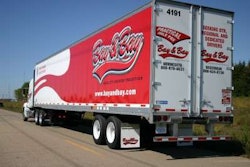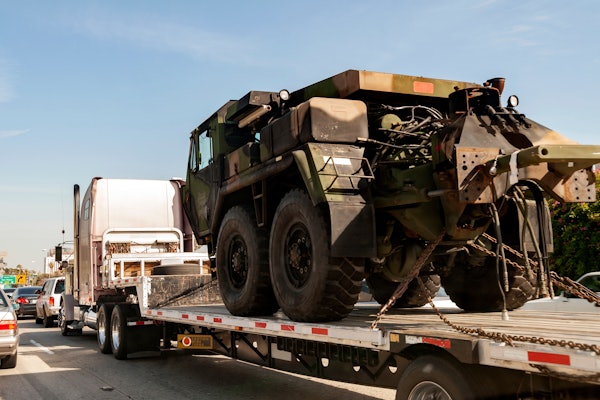Congress passed legislation to grant short-term relief to corporations from the financial burden of stricter pension funding requirements imposed by the Pension Protection Act of 2006. The American Trucking Associations said the law would help ease the financial strain on American businesses due to the lagging economy and current volatility in the financial markets.
Preliminary data show almost 10 percent fewer people were killed in traffic accidents during the first 10 months of 2008, the U.S. Department of Transportation reported. Although DOT’s announcement did not mention it, the number of highway miles driven was down by a similarly dramatic degree last year.
Freight Transportation Services Index rose 1.0 percent in October from its September level after two consecutive monthly declines, the U.S. Department of Transportation’s Bureau of Transportation Statistics reported.
U.S. District Court for South Dakota granted a request to immediately halt the operations of Action Carrier Inc. of Sioux Falls. The Federal Motor Carrier Safety Administration said it had initiated three separate civil penalty proceedings against Action Carrier over the last year for operating without insurance and operating after revocation of authority.
President-elect Barack Obama on Dec. 19 named U.S. Rep. Ray LaHood, a seven-term Republican from Illinois, as his choice for the next U.S. Transportation Secretary. If approved by the Senate, LaHood, 63, would succeed Secretary Mary Peters, who has served since 2006.
Joan Claybrook is stepping down as president of Public Citizen on Jan. 31 after 27 years leading the organization, which has been one of the trucking industry’s most active and successful critics in recent years. Claybrook will remain on the board of directors.
Wabash National Corp. conducted an extended shutdown of its Lafayette, Ind., plant over the holidays and is returning all but 800 employees through Feb. 3. The remaining employees are slated to return to work during the second quarter.
Los Angeles will receive $210 million in U.S. Department of Transportation funding to help reduce congestion and establish better bus transit services. The grant – the most DOT has awarded to a city to date for congestion relief – will help fund a plan to convert existing HOV lanes to high-occupancy toll lanes and implement congestion pricing.
U.S. Department of Transportation’s Office of Inspector General is auditing the effectiveness of the Federal Motor Carrier Safety Administration’s National Motor Coach Safety Program, which includes several measures aimed at tightening enforcement on passenger carriers.
Con-way Freight said it was cutting its work force nationwide by about 8 percent, or 1,450 positions. The company said volume in its year-over-year tonnage was down 3.8 percent in October and 9.2 percent in November from the respective 2007 months.
Celadon Group acquired Little Rock, Ark.-based Continental Express’ book of business, 400 tractors and 1,100 trailers for about $24 million.
In what might be its most far-reaching regulation of commercial trucks and trailers to date, the California Air Resources Board (CARB) last month adopted rules that require retrofit or replacement of virtually all trucks now operating in California and mandate tire and aerodynamic-related specifications in an effort to reduce greenhouse gases.
The statewide bus and truck rule requires fleet owners to begin replacing older trucks operating in California or retrofitting them with diesel exhaust filters, beginning in 2011. Under the rules, almost all vehicles covered would be replaced or upgraded by 2014. Owners also must replace engines older than the 2010 model year under an implementation schedule running from 2012 to 2022.
CARB’s heavy-duty greenhouse gas reduction measure requires long-haul operators of 53-foot box type – dry van and refrigerated – trailers to use fuel-efficient tires and to incorporate aerodynamic devices certified by the SmartWay Transport Partnership. New trailers must incorporate the tire and aerodynamic specs now; older trailers must be retrofit by 2013, although there is an extended period option that involved reporting.
As for tractors, low rolling-resistance tires will be required for all new ones – both day cabs and sleepers – pulling 53-foot box-type trailers effective with the 2011 model year. As of 2012, older tractors must use low rolling-resistance tires. In addition, CARB still plans to require that sleeper-equipped tractors pulling 53-foot box-type trailers be SmartWay-certified models as of model year 2011. However, the board conditioned this requirement on the availability of a certification procedure that allows fuel-efficiency comparisons across all makes of tractors. The current SmartWay procedure allows only for comparison of models within one make.
In the final version of the statewide bus and truck regulation – aimed at reducing particulate matter and oxides of nitrogen – CARB responded to pleas from business groups about costly regulations in the face of a poor economy by delaying implementation for a year. The original proposal would have required fleet owners to begin upgrading equipment in 2010. The board also allowed fleet owners to delay compliance for a year for every older-technology truck they retired.
Three days before the vote on the truck and bus regulation, CARB issued a news release highlighting the results of a recent research study that concluded that trucking industry workers who have had regular exposure to diesel and other types of vehicle exhaust showed an elevated risk of lung cancer with increasing years of work.
“This study simply shows that older outdated engines, which are no longer being produced, may have been more hazardous than those used today,” says ATA spokeswoman Tiffany Wlazlowski. “The fact that those engines produced higher emissions was the impetus for the progressive approach the trucking industry has taken to not only reduce negative effects on the environment, but also improve the health of highly-valued drivers.”
CARB’s principal focus with the statewide bus and truck regulation is not the typical long-haul trucking operation that is operating newer, cleaner equipment – but rather California-based short-haul operators that often operate much older equipment. On the other hand, CARB’s greenhouse gas reduction measure is directed specifically at long-haul trucking operations and so affects more carriers based outside of California than those based there. (For more on the implications of these regulations for fleet owners, see “The Golden State Rules,” December 2008).
Details on the heavy-duty vehicle greenhouse gas reduction measure are available at www.arb.ca.gov/regact/2008/ghghdv08/ghghdv08.htm. For more information on the statewide bus and truck regulation, go to www.arb.ca.gov/regact/2008/truckbus08/truckbus08.htm.
– Avery Vise
FMCSA tightens new entrant rules
New entrants will have to survive a more rigorous test of their safety fitness under new rules issued by the Federal Motor Carrier Safety Administration. The regulations, published in the Dec. 16 Federal Register, identify 16 violations that FMCSA deems to be essential elements of basic safety management controls necessary to operate in interstate commerce. Failure to comply with any one of those 16 regulations results in an automatic failure of the new entrant safety audit, which is supposed to occur within the first 18 months of a new entrant’s operation.
The new regulations also will require that new entrants correct certain deficiencies found in roadside inspections on an expedited basis. FMCSA also will check compliance with the Americans with Disabilities Act and certain household goods-related requirements in the new entrant safety audit, if applicable. Failure to comply with these requirements won’t affect the outcome of the safety audit, but the agency will take action to improve compliance.
FMCSA also has improved its educational and technical assistance (ETA) materials to ensure applicants understand applicable federal motor carrier safety standards. And the agency is eliminating the safety certification application for a USDOT number (Form MCS-150A), saying it is not effective for establishing a carrier’s knowledge of safety requirements.
Among the 16 “sudden death” violations, 14 would lead to failure of an audit based on a single occurrence. Two regulations – failing to require a driver to make a record of duty status, and using a commercial motor vehicle not periodically inspected – require a threshold of 51 percent or more of examined records to trigger automatic failure. The agency said use of thresholds responded to complaints that a single occurrence standard would unfairly discriminate against larger new entrants.
The rule takes effect in mid-February – well into the Obama administration. If the incoming regime does not like the new rule for any reason, it can basically invalidate it. Had the rule taken effect before President-elect Barack Obama’s inauguration on Jan. 20 – as is the case with the final hours-of-service regulation – the new administration would face a more cumbersome process for undoing the regulations. It’s not clear, however, that the Obama administration will have any problem with the new entrant regulation.
The only other FMCSA rulemaking still pending at the White House is a final rule regarding electronic onboard recorders. FMCSA hopes to publish the EOBR rule before Obama is sworn in on Jan. 20. But since the effective date of the rule would be well beyond that date, it would be up to the Obama administration to decide whether to follow through with it.
For more information on the new entrant safety assurance process, go to www.regulations.gov and search FMCSA-2001-11061.
The 16 deadly sins
The 16 violations FMCSA has determined should result in automatic failure of the audit are:
- Failing to implement an alcohol and/or controlled substances testing program.
- Using a driver known to have an alcohol content of 0.04 or greater to perform a safety-sensitive function.
- Using a driver who has refused to submit to an alcohol or controlled substances test required under part 382.
- Using a driver known to have tested positive for a controlled substance.
- Failing to implement a random controlled substances and/or alcohol testing program.
- Knowingly using a driver who does not possess a valid CDL.
- Knowingly allowing, requiring, permitting or authorizing an employee with a commercial driver’s license that is suspended, revoked or canceled by a state or who is disqualified to operate a commercial motor vehicle (CMV).
- Knowingly allowing, requiring, permitting or authorizing a driver to drive who is disqualified to drive a CMV. (This violation refers to a driver operating a CMV as defined under












